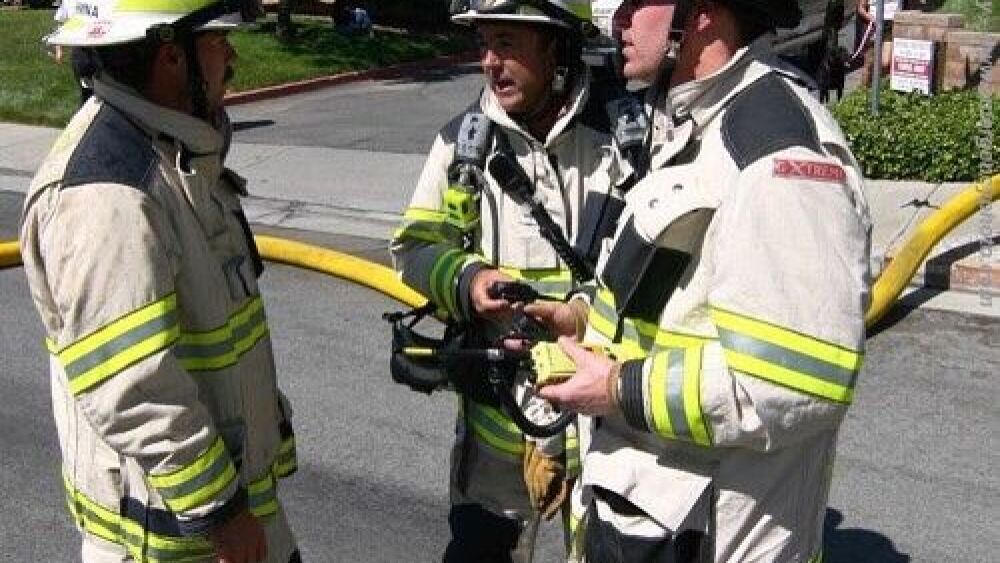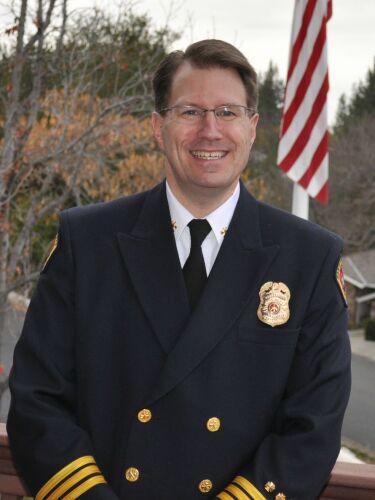Running command for your first time is a stressful experience, particularly because it’s almost impossible to get actual on-the-job training for commanding a fire. As such, mentoring, coaching and on-scene guidance are critical.
Steve Prziborowski, deputy chief for the Santa Clara County (California) Fire Department, has over 27 years of fire service experience, the last 13 as a chief officer – and he’s run more than a few fires in his day.
Prziborowski relayed a story of how he arrived on the fire scene (as a deputy chief) and offered his expertise to a new battalion chief: “I could tell the new battalion chief was a bit overwhelmed, and he was very happy to see me. I had a smile on my face and asked, ‘How can I assist?’ He said, ‘How about hanging out here for a bit?’ As he was doing a good job assigning personnel and resources, I remember him almost using up all of his resources in staging, and the incident was nowhere near being under control. I kindly chimed in, ‘Have you considered requesting a third alarm?’ He had not, but immediately got on the radio requesting one, looking at me and saying, ‘Thank you.’ I realize he would have eventually caught that he needed one, but I’ve also realized how easy it is at the command post to get task overloaded and sometimes forget key things because of all the distractions. This is a team sport, and there should be no harm in having as much support as possible at the command post, especially for a new officer who has not had the opportunity to command many (if any) fires.”
Prziborowski’s story is not uncommon. Firefighters of various ranks from across the country, from departments big and small, are seeking guidance when it comes to this critical component of fire service leadership.
FireRescue1/Fire Chief caught up with Prziborowski about the challenges of training new officers to serve as ICs, detailing incident command training types, first fire do’s and don’ts, radio skills resource management, and more.
FireRescue1: What is the best approach for training new officers to command their first fire?
Prziborowski: While there is no one-size-fits-all solution for anything, the best approach is through simulated training. This training can occur in the firehouse, the classroom and even in the field.
While many point fingers at their leadership, saying they are not being sent to enough training classes on or off the job, or that their department as a whole is not fully preparing them to do their job (and the one they may be preparing for), there is a much cheaper and easier method: mentoring and coaching by one’s supervisor.
For example, a firefighter or engineer preparing to be a captain or a captain preparing to be a battalion chief should have that person (their supervisor in the respective position) mentor and coach them to be the best they can be. This can easily be done on duty in the course of the daily activities, but it requires both parties to have an appreciation for both personal and career development. Further, this can be done at no cost, the only cost being time.
While there are several various simulation software programs one can purchase to use, it can also be as simple as taking a magazine or newspaper picture with fire or finding pictures and videos on the internet or social media. Since it’s almost impossible to get actual on-the-job training for commanding a fire – since those who aspire to command a fire are usually required to do their regular duties at an actual fire until they’re actually in a position to act or serve in the position – the next best thing is simulated events. It’s a great way for senior personnel to transfer their knowledge, skills, abilities and experiences to those who want to step up to command a fire, especially in a comfortable and controlled, simulated environment.
What types of training should be employed to ensure new officers are able to successfully command a fire?
Similar to what I discussed above, I truly feel simulated incidents can be very valuable to help set someone up for success in their current and future position.
While it may not be feasible given a department’s staffing or finances, if there is any chance of having a senior officer be able to serve as an on-scene or at the command post mentor or advisor to offer suggestions or advice, while not having to be actively involved in managing the incident, that would be ideal.
For example, as a deputy chief, when I show up at a fire, the first thing I do is check-in at the command post, with one of our three on-duty battalion chief who is serving as the incident commander (IC). I’m not there to take over the fire; I’m there to assist and support them as needed. While some might say a deputy chief should take over from the battalion chief since they are senior in rank, unless that is required for political or exigent circumstances, I’m all for letting the on-duty battalion chiefs run the incident. Why? Because they are the ones who do that job every day and should be the most proficient at it given the practice they should be getting or having to prepare for such incidents.
So, when I arrive and ask the IC how I can best assist them, most of the time they usually have things headed in the right direction. If they are a new battalion chief, I’ll also usually ask if they don’t mind if I hang out and assist them at the command post, either being their scribe or just there to bounce things off of, and they are usually happy to allow me to do that.
Considering the myriad duties involved in serving as an IC, should new officers use a combination of both hands-on training and classroom training? If so, what is an ideal breakdown in terms of how to spend training time?
That’s a no-brainer, as Chief Alan Brunacini used to say, God rest his soul.
It’s hard for me to put an actual percentage of how much time should be spent on each because everyone of us learns and retains information differently. The key is knowing yourself, or if you are responsible for training and mentoring others, trying a combination of both to see what produces the best outcome for the individual you are assisting.
In a perfect world, the two can be combined, meaning, with a group of individuals, a department can take a batch of devices (iPads, laptops, desktops, whatever) and put them in a classroom and have personnel at each, serving in different incident capacities at a simulated fire. Then, have a command buggy handy, open up the back doors or sit in the front seats, and have the IC there, along with support staff they can muster up.
If you’re really ambitious or have the available resources, you maybe even do it at your training center with actual apparatus, having a live training burn, and then make it into a full event.
Are there a few standard do’s and don’ts you recommend for commanding your first fire?
While I can think of many, I’ll narrow it down to the following:
Do understand and know the NIOSH 5 (the items NIOSH has determined to be the most common causal factors to line-of-duty deaths and injuries):
- Improper Risk Assessment
- Lack of Incident Command
- Lack of Accountability
- Inadequate Communications
- Lack of SOPs or failure to follow established SOPs
Do remain calm, cool and collect. Remember it’s all about command presence. If you are the IC and you’re screaming or running around like the sky is falling, it’s not going to project much confidence to your troops. However, if you’re acting like a duck (calm above water in front of everyone, but maybe paddling hard under water out of everyone’s view), that can be a good thing.
Do remember it’s always better to call for resources earlier as opposed to later. You can always send them home if not needed, but it sure is lonely to look over at an empty staging area when you are in dire need of additional resources, knowing the lag time to have your dispatch center tone out those additional resources, not to mention the travel time to get them there when you needed them yesterday.
Don’t let task overload set in. It’s extremely easy to let that happen, and it can lead to tragic outcomes. Anyone who has served as an IC hopefully knows how lonely it can be at the command post, especially when you’re trying to do multiple things at once:
- Talk on the radio;
- Listen to the radio (sometimes multiple channels);
- Have others come up to you asking for assignments or providing you information;
- Process through your eyes and ears what is going on – for the better or the worse; and
- Document on your tactical worksheet what is occurring, especially when it comes to tracking your resources and progress.
I don’t know anybody who can do all 5, let alone two of the above items exceptionally well. The term multi-tasking is a fallacy as most cannot do more than one thing effectively, especially in a high-stress situation. The best way to help solve this problem is ensuring you have sufficient personnel at the command post to help you fill each of those roles so that you can act like an orchestra director, as opposed to a chicken running around with its head cut off.
Don’t think you can handle everything without having to request mutual-aid resources. It is sad to hear in today’s world that some departments do not like to request mutual aid from their neighbors because it is embarrassing to have to do so, since the perception is they cannot handle their own fires. Get over that! Do what is best for your personnel and community. If your department cannot muster at least 15 personnel for a working fire, and then provide more if the incident warrants, then request mutual aid.
Sadly, I know of many departments across the United States that don’t even have 15 personnel on duty, let alone 10, and think they can handle any and all fires without requesting mutual aid. What happens is they end up pushing and working their personnel more than they need and more than is safe and reasonable, and they end up not providing the best service to their community because they allow their egos to eat their brains (another Chief Brunacini saying).
Don’t work your personnel too hard, to the point of them being a hazard to themselves or others. Yes, we are fortunate that we have many “type A personality” individuals serving the fire service, but sometimes we can all be our own worst enemy. Don’t baby them, but also keep an eye out for fatigue, stress or other signs or symptoms of bag things waiting to happen. I don’t know of any firefighter that wants to go to rehab or be told to vacate the building and go defensive, but sometimes the IC needs to be the designated adult, the voice of reason, or the one that helps save someone from themselves, to allow them to fight another fight in the future.
Describe some of the essential radio skills a new IC needs to successfully command a fire.
The most essential radio skills for the new IC to successfully command a fire are:
- Think before you speak.
- Keep it short and sweet, and to the point.
- Stay away from wasted time phrases such as “be advised,” “at this time,” “do you have anything further?”
- Be clear and concise; no need for huge words or long sentences.
- Repeat back what is asked of you when possible; answering “copy” doesn’t always ensure you heard the key information that may have been relayed to you.
What types of technology should new officers consider using as they train for and begin commanding fires?
I’m a fan of keeping it simple. Technology can be beneficial, but it does have its potential challenges or limitations.
Using computer simulation software to build and play simulated incidents is great, as there are virtually no obvious limitations I can think of. Using the internet or social media can also be very beneficial since it is usually free and easy to access.
While it’s easy to practice by yourself, it’s also important to involve others with experience to offer you feedback and words of wisdom and experience as you go through your process of managing that fire.
How should new officers train for commanding high-risk/low-frequency incidents?
Going back to using simulated events with experienced mentors and coaches as previously mentioned, I cannot think of any other way except doing that as much as you can. One can never practice too much for the big one that may not come too often, but when it does, you better be as prepared as you to manage it.
How can a new officer best manage multiple crews on scene, knowing how to prioritize and deploy resources?
Knowing that one of the NIOSH top 5 is related to command and control (or lack thereof), it’s critical that the IC ensures they have sufficient (if not excessive) personnel not just operating on the fire but supporting the fire and the command efforts at the command post. I know it’s not a perfect world, but if it was and I was the IC, I would ensure there are at least three other chiefs at the command post to assist me:
- One to listen to and talk on the radio (on my behalf) and monitor all traffic, keeping the rest of our team informed of key issues
- One to be the scribe, to document on the tactical worksheet who is on scene, where they are operating and what they are doing, who is in staging (resource status), what is going on related to objectives (situation status), etc.
- One to play blocker – the person who doesn’t allow anyone to get to me without going through them first. They are there to ensure I don’t get overwhelmed or distracted so that I can focus on being the orchestra leader and not focused on one thing that would take me away from processing everything that is going on.
If I could have a fourth chief at the command post, it would be someone in a higher rank or with more experience to serve as the senior advisor. Even if I was the most experienced person on the incident, it can never hurt to have an extra set of eyes or ears to say, “Did you think of this?” or “Have you considered that?” or “As a suggestion ….”
When all else fails, if you find yourself as the only person at the command post as the IC and the rest are operating on mitigating the fire, do the best you can with what you have to work with, do your best to not get overwhelmed or allow task saturation to get the best of you (if that is even possible), and try to focus on what is most important – watching the incident with the 30,000-foot view, listen to the radio, and ensure you know where everyone is, whether it is in your head or on a piece of paper.





